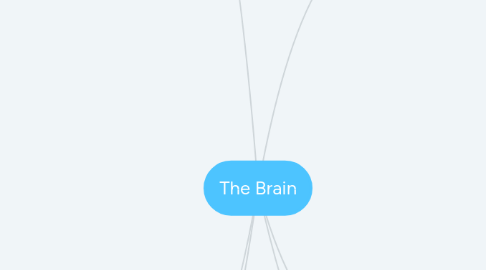
1. 4 Major Brain Regions and Landmarks
1.1. The Cerebrum- The largest part of the brain. Responsible for conscious thoughts, sensations, intellect, memory, and complex movements
1.1.1. White Matter of the Cerebrum- Association fibers, commissural fibers, prjection fibers
1.1.2. Basal Nuclei- masses of gray matter that lie within each hemisphere deep to the floor of the lateral ventricle . They are embedded in the white matter of the cerebrum
1.2. The cerebellum- the second-largest part of the brain. Responsible for adjusting ongoing movements by comparing arriving sensations with previously experienced movements.
1.2.1. Structure of the Cerebellum- highly complex convoluted surface composed of gray matter called the cerebellar cortex
1.2.2. Functions of the Cerebellum- Adjusting the postural muscles of the body, Programming and fine-tuning movements controlled at the conscious and subconscious levels,
1.3. The Diencephalon- Made up of thalamus, hypothalums.
1.3.1. Hypothalamus- Contians centers involved with emotions, autonomic function, and hormone production
1.3.1.1. Structure of the Hypothalamus- extends from the area superior to the optic chaism to the posterior margins of the mammillary bodies
1.3.1.2. Functions of the Hypothalamus- Secretions of two hormones (antidiuretic hormone (ADH) and oxytocin), regulates body temperature, control of autonomic function, coordination between voluntary and autonomic functions, coordination of activities of the nervous and endocrine system, regulations of circadian rhythms, subconscious control of skeletal muscle contractions,, and production of emotions and behavioral drives
1.3.2. Thalamus- Contains relay processing centers for sensory information.
1.3.2.1. Structure of the Thalamus- the third ventricle seperates the thalamus into left and right sides. Each side consists of a rounded mass of groups of thalamic nuclei
1.3.2.2. Functions of the Thalamic Nuclei- The anterior nuclei- part of the limbic system, effects emotional states and integrates sensory information. Medial nuclei- provides awareness of emotional states by connecting emotional centers int he hypothalamus with the frontal lobes of the cerebral hemisphere. Ventral nuclei- relay information from the basal nuclei of the cerebrum and the cerebellum to somatic motor areas of cerebral cortex. Dorsal nuclei- integrate sensory information for sending signals to the cerebral cortex
1.4. Midbrain- Processes visual data and auditory data, genereats reflexive somatic motor, and maintains consciousness. Part of the Brainstem
1.5. Pons- relays sensory information to cerebellum and thalamus, and subconscious somatic and visceral motor centers. Part of the brainstem
1.5.1. Sensory and Motor Nuclei of Cranial Nerves- Cranial nerves )V, VI, VII, and VIII) innervate the jaw muscles, the anterior surface o the face, of the the extrinsic eye muscles, and the sense organs of the internal ear
1.5.2. Nuclei Involved with the Control of Respiration- two pontine centers- apnuestic and pneumotaxic are the centers that appear to modify breathing activities
1.6. Medulla Oblongata- Relays sensory information to thalamus and to other portions of the brain. Autonomic centers regulation of visceral function. Part of the Brainstem.
1.6.1. Reflex Centers: Autonomic and Reflex activity- the reticular formation is a closely intermingled mass of gray and white matter that contains embedded nuclei. Two major groups of reflex centers in the medula oblangata, cardiovascular and respiratory
1.6.2. Sensory and Motor Nuclei of Cranial Nerves- contains sensory and motor nuclei associated with 5 of the cranial nerves (VIII, IX, X, XI, and XII). Provide motor commands to muscles to pharynx, neck, and back, as well as to the visceral organs of the thoracic and peritoneal cavities
1.6.3. Relay Stations along Sensory and Motor Pathways- the gracile nucleus, and the cuneate nucleus pass somatic sensory information to the thalamus
2. Cerebrospinal Fluid- Completely surrounds and bathes the exposed surfaces of the CNS. Important functions include: supporting the brain, cushioning the brain, and transporting nurtrients
3. The Cerebral Cortex
3.1. Frontal Lobes- Primary motor cortex- Voluntary control of the skeletal muscles
3.2. Parietal Lobe- Primary somatosensory cortex- Conscious perception of touch, pressure, pain, vibration, taste, and temperature.
3.3. Occipital Lobe- Visual cortex- conscious perception of visual stimuli
3.4. Temporal Lobe- Auditory and olfactory cortex- conscious perception of auditory and olfactory (smell) stimuli
3.5. ALL LOBES- Integration and processing of sensory data; processing and initiation of motor activities
4. Ventricles of the Brain
4.1. Setum pellucidum, thin plate of brain tissue tissue that seperates the two lateral venticles
4.2. Lateral ventricles- separates the two hemispheres- a fluid-filled chamber within the cerebral hemisphere
4.3. Third ventricle- located in the diencephaon. Communicates with both lateral ventricles through an interventricular foramen.
4.4. Fourth ventricle- connects to the third ventricle through the cerebral aqueduct.
5. Cranial Meningies
5.1. Dura mater- consists of outer and inner fibrous layer. The outer periosteal cranial dura and inner meningeal cranial dura are typically fused together
5.1.1. Dural enous sinuses- large collecting veins located within the dura fold. They open into these sinuses deliver the venous blodd to the veins of the neck
